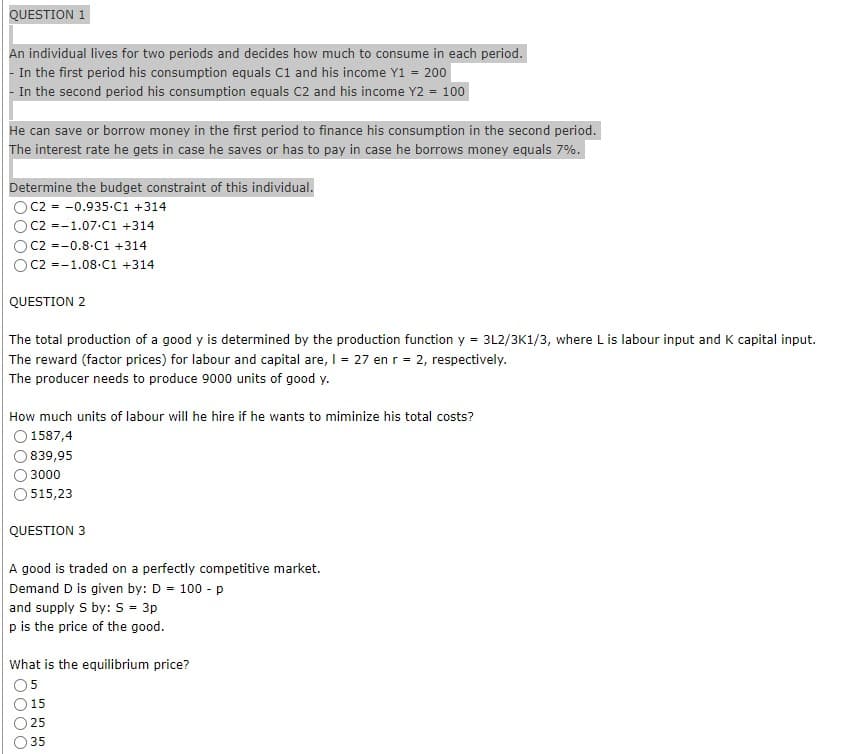QUESTION 1 An individual lives for two periods and decides how much to consume in each period. - In the first period his consumption equals C1 and his income Y1 = 200 - In the second period his consumption equals C2 and his income Y2 = 100 He can save or borrow money in the first period to finance his consumption in the second period. The interest rate he gets in case he saves or has to pay in case he borrows money equals 7%. Determine the budget constraint of this individual. C2 = −0.935·C1 +314 C2 =−1.07·C1 +314 C2 =−0.8·C1 +314 C2 =−1.08·C1 +314
QUESTION 1 An individual lives for two periods and decides how much to consume in each period. - In the first period his consumption equals C1 and his income Y1 = 200 - In the second period his consumption equals C2 and his income Y2 = 100 He can save or borrow money in the first period to finance his consumption in the second period. The interest rate he gets in case he saves or has to pay in case he borrows money equals 7%. Determine the budget constraint of this individual. C2 = −0.935·C1 +314 C2 =−1.07·C1 +314 C2 =−0.8·C1 +314 C2 =−1.08·C1 +314
Chapter17: Capital And Time
Section: Chapter Questions
Problem 17.8P
Related questions
Question
QUESTION 1
An individual lives for two periods and decides how much to consume in each period.
- In the first period his consumption equals C1 and his income Y1 = 200
- In the second period his consumption equals C2 and his income Y2 = 100
He can save or borrow money in the first period to finance his consumption in the second period.
The interest rate he gets in case he saves or has to pay in case he borrows money equals 7%.
Determine the budget constraint of this individual.
C2 = −0.935·C1 +314
C2 =−1.07·C1 +314
C2 =−0.8·C1 +314
C2 =−1.08·C1 +314
QUESTION 2
The total production of a good y is determined by the production function y = 3L2/3K1/3, where L is labour input and K capital input.
The reward (factor prices) for labour and capital are, l = 27 en r = 2, respectively.
The producer needs to produce 9000 units of good y.
How much units of labour will he hire if he wants to miminize his total costs?
The total production of a good y is determined by the production function y = 3L2/3K1/3, where L is labour input and K capital input.
The reward (factor prices) for labour and capital are, l = 27 en r = 2, respectively.
The producer needs to produce 9000 units of good y.
How much units of labour will he hire if he wants to miminize his total costs?
1587,4
839,95
3000
515,23
839,95
3000
515,23
QUESTION 3
A good is traded on aperfectly competitive market.
Demand D is given by: D = 100 - p
and supply S by: S = 3p
p is the price of the good.
What is theequilibrium price ?
A good is traded on a
Demand D is given by: D = 100 - p
and supply S by: S = 3p
p is the price of the good.
What is the
5
15
25
35
15
25
35

Transcribed Image Text:QUESTION 1
An individual lives for two periods and decides how much to consume in each period.
In the first period his consumption equals C1 and his income Y1 = 200
In the second period his consumption equals C2 and his income Y2 = 100
He can save or borrow money in the first period to finance his consumption in the second period.
The interest rate he gets in case he saves or has to pay in case he borrows money equals 7%.
Determine the budget constraint of this individual.
C2 = -0.935-C1 +314
C2 -1.07.C1 +314
C2 =-0.8-C1 +314
C2 -1.08.C1 +314
QUESTION 2
The total production of a good y is determined by the production function y = 3L2/3K1/3, where L is labour input and K capital input.
The reward (factor prices) for labour and capital are, I = 27 en r = 2, respectively.
The producer needs to produce 9000 units of good y.
How much units of labour will he hire if he wants to miminize his total costs?
O 1587,4
839,95
3000
515,23
QUESTION 3
A good is traded on a perfectly competitive market.
Demand D is given by: D = 100 - p
and supply S by: S = 3p
p is the price of the good.
What is the equilibrium price?
5
15
25
35
Expert Solution
This question has been solved!
Explore an expertly crafted, step-by-step solution for a thorough understanding of key concepts.
This is a popular solution!
Trending now
This is a popular solution!
Step by step
Solved in 2 steps

Follow-up Questions
Read through expert solutions to related follow-up questions below.
Knowledge Booster
Learn more about
Need a deep-dive on the concept behind this application? Look no further. Learn more about this topic, economics and related others by exploring similar questions and additional content below.Recommended textbooks for you

